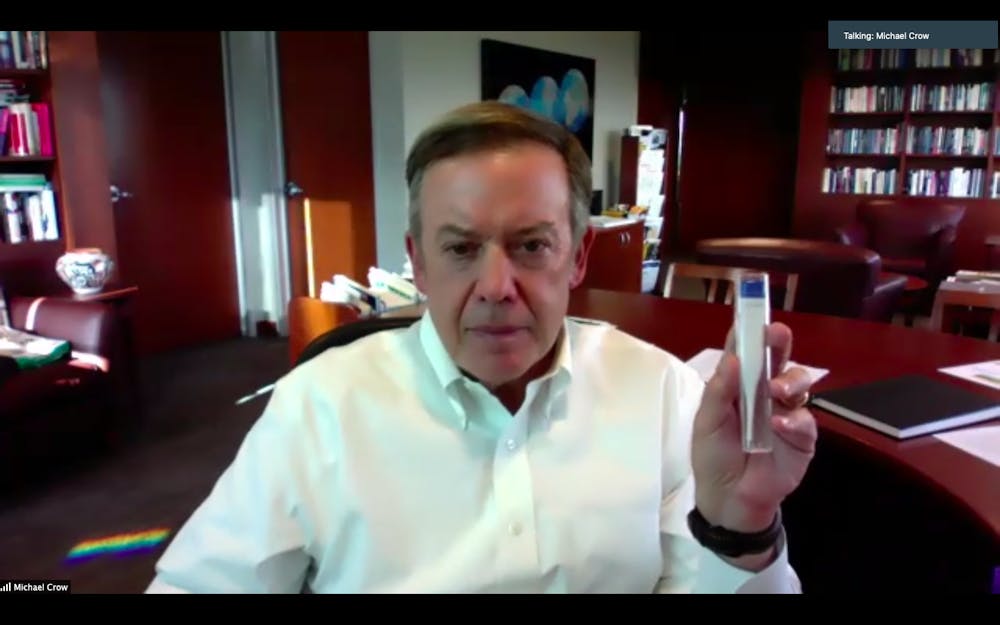Since reopening on Aug. 20, about 20% of the ASU student body has returned to campus, while the University works to adapt its community to a life with the coronavirus that has infected more than 1,600 students.
In an interview with The State Press Wednesday, ASU President Michael Crow and other officials said the University is managing a reactive, adaptive and changing relationship with the coronavirus.
The University is in "full management mode" from what University administrators expect to be a "transformational event" for society, Crow said.
Crow and other officials said the University's response has mainly been about providing students the option to come to campus or not while still maintaining safety and following guidelines from internal physicians, the Arizona Department of Health Services and the Centers for Disease Control and Prevention.
What caused the University to change the end of semester schedule, and what is it doing to support faculty as they change deadlines and coursework?
On Friday, the University announced all instruction would take place remotely following Thanksgiving break and finals week would be conducted virtually during the week of Nov. 30 instead of the week of Dec. 7.
READ MORE: Instruction to take place remotely after Thanksgiving break
"The schedule was altered because of the advice we'd received about the possible dealings of the complexities of a flu outbreak," Crow said. "What we're attempting to do is manage unknowns at the moment."
Crow said allowing students to return home for a holiday break and return to campus would have created an unpredictable and uncertain scenario.
"We have asked our faculty to be flexible and adaptable from the outset because it is impossible for us to know exactly what will unfold as the semester progresses," said Vice Provost for Undergraduate Education Frederick Corey.
How many students and faculty have returned to campus for in-person instruction and activities?
According to Crow, approximately 30% of 12,400 employees and 20% of 74,500 students are coming to campus. These numbers are not the number of people who come to campus daily but reflect the entire population of each group that has come to campus throughout any given week.
Corey said the reason the University has not released concrete numbers thus far is because students move back and forth with in-person and Zoom using the ASU Sync model based on personal circumstances, which was the University's ultimate goal.
"The design of everything was personal responsibility and personal choice," Crow said.
Crow said decline in community cases was a main reason for University's continued operation
Active COVID-19 cases within the ASU community have declined over the past several weeks. According to an update Monday evening, the University had 263 active cases among both employees and students.
READ MORE: Randomly selected COVID-19 tests now reflected in ASU data
Joanne Vogel, vice president of student services, said there are currently 86 active positive cases in ASU's residence halls.
"We decided that we would try to manage the University with a certain percentage of the population of the student body that would be positive," Crow said. "And so we planned on a certain small percentage of the student body becoming positive."
Crow said unlike the plans of some other large universities, his team planned to see more than 100 cases on campus.
"(Other schools) underestimated what would be necessary to manage students that tested positive," Crow said. "We didn't assume, 30 or 50 cases, we assumed 10 or 20 times that (would test positive)."
How long have you been communicating with nearby apartment buildings, businesses and restaurants about University policy?
The University has been communicating with local businesses and apartment complexes to encourage ASU’s public health guidelines beyond just the campus, Crow said.
James Rund, senior vice president for Educational Outreach and Student Services, said the University began engaging local apartment complexes that house predominantly ASU students this summer by providing them Community of Care signage, information and a point of contact with the University when they had concerns.
According to a University spokesperson, before the semester began, $3,167.44 was spent on providing the signage to local partners.
READ MORE: A financial breakdown of the millions ASU has spent addressing COVID-19
The University has received positive reactions from the local partners and has helped create a safer environment for ASU students, Crow said.
"The proof is in the pudding, we — right now — don't appear to have a rapidly moving outbreak," Crow said. "We appear to have a virus which is being, quote-unquote, knock on wood, managed."
What benchmarks exist that have helped the University make operational changes?
The University did not set benchmarks publicly because the coronavirus changes, county response changes, state response changes and national response changes, Crow said.
Instead, the University planned for "a certain small percentage of the student body becoming positive," Crow said. The University did not say what that percentage was, but Crow said it would manage the coronavirus as situations change.
"What we did communicate was that we were going to manage our way with the virus," Crow said. "We do have a plan to manage, we operate under the assumption that the virus would be moving through society."
Crow said a group of about 150 people meeting since December help the University make plans and change them when necessary. A group focused on testing has roughly 50 members and there are equal parts working on epidemiology and student services.
How is the University utilizing data from the daily health check, and what additional changes to the app can students expect?
Crow acknowledged the ASU health check app is "glitchy" but is providing "excellent service."
"The only thing we are interested in is two things: people checking their symptoms and the percent of people having symptoms and guiding people into staying home," Crow said.
He said the data is "not person-specific and is wiped clean after two weeks, so we're not doing anything with the data."
Interim Executive Vice President of ASU's Knowledge Enterprise, Neal Woodbury, said the app gives an "overall impression" of whether there is a big health problem with the ASU community while also reminding students and employees to think about their health every morning.
Crow said the app post-coronavirus "could be a powerful tool for producing and maintaining a better and more healthy university environment."
Reach the reporters at pjhanse1@asu.edu and wmyskow@asu.edu and follow @piperjhansen and @wmyskow on Twitter.
Like The State Press on Facebook and follow @statepress on Twitter.

Wyatt Myskow is the project manager at The State Press, where he oversees enterprise stories for the publication. He also works at The Arizona Republic, where he covers the cities of Peoria and Surprise.

Piper Hansen is the digital editor-in-chief at The State Press, overseeing all digital content. Joining SP in Spring 2020, she has covered student government, housing and COVID-19. She has previously written about state politics for The Arizona Republic and the Arizona Capitol Times and covers social justice for Cronkite News.




